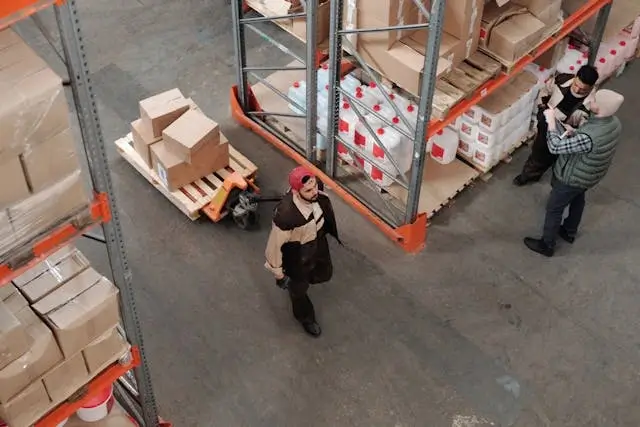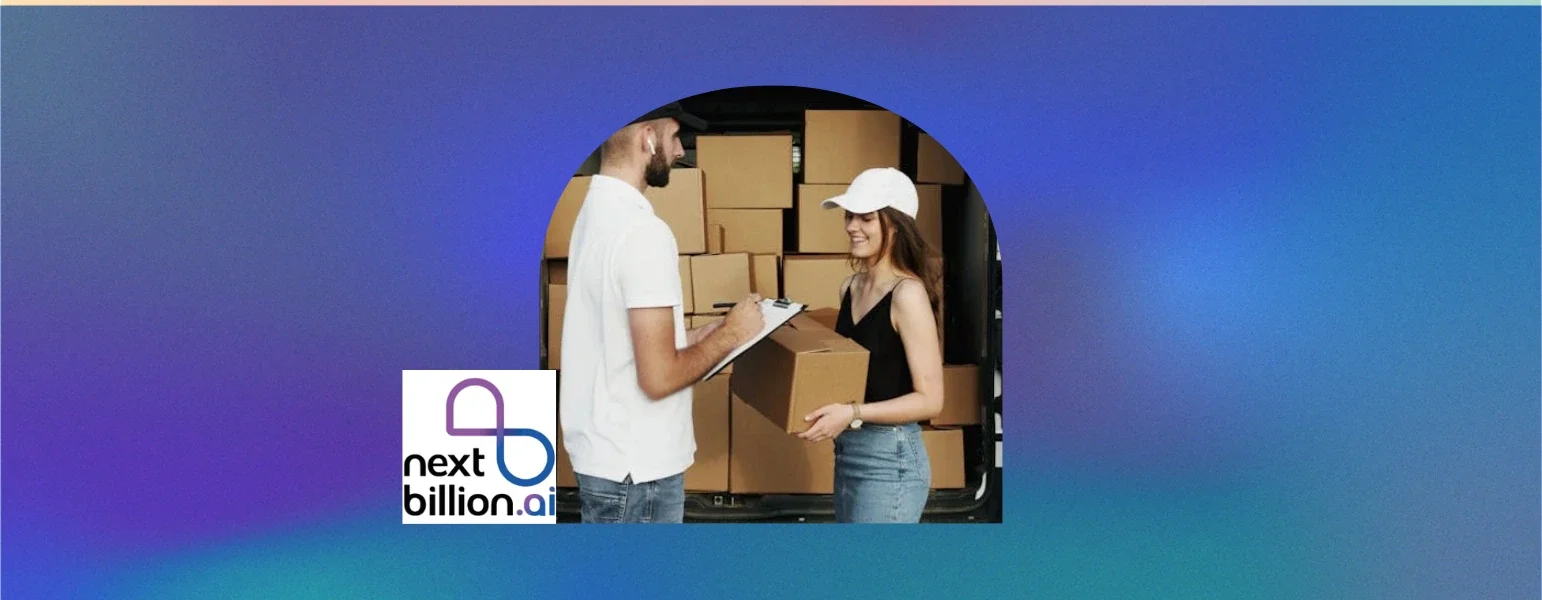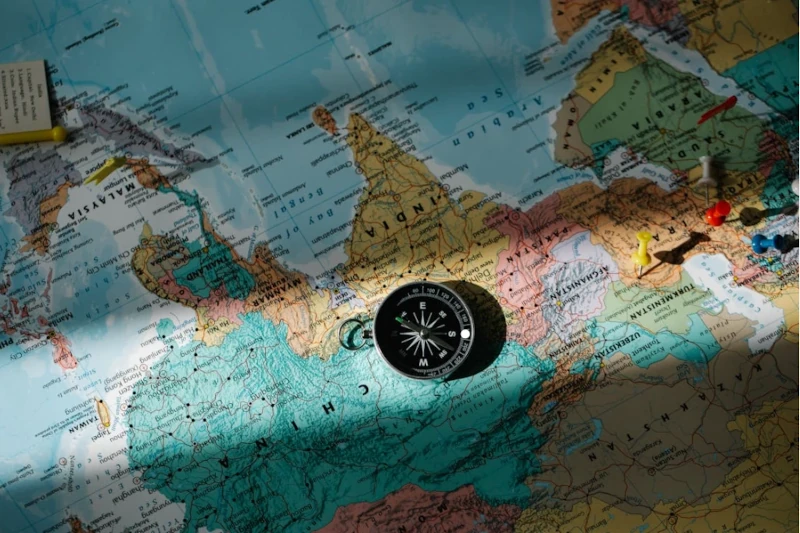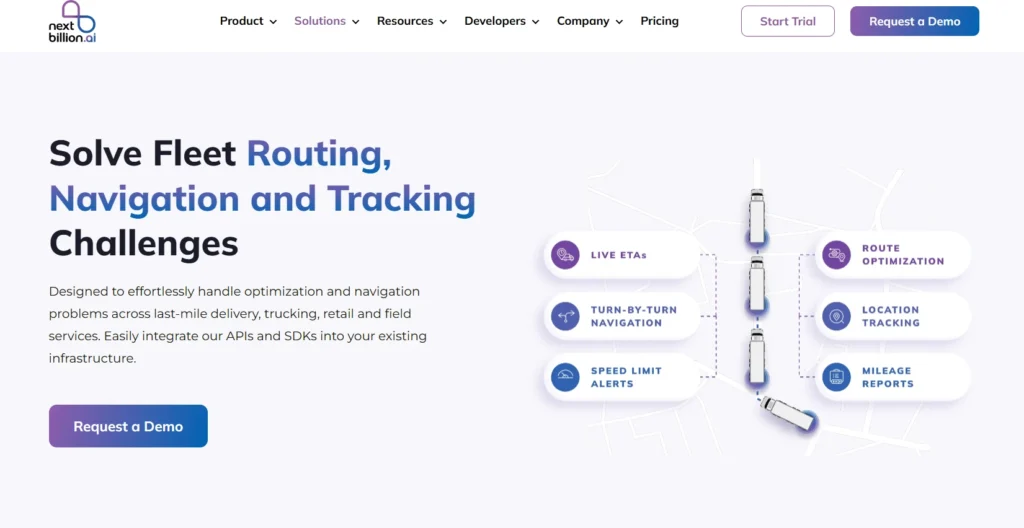

- BLOG
From CRM to Last-Mile Delivery: How Nextbillion.ai Enhances Fleet Efficiency
Published: August 26, 2025
Route Optimization API
Optimize routing, task allocation and dispatch
Distance Matrix API
Calculate accurate ETAs, distances and directions
Directions API
Compute routes between two locations
Driver Assignment API
Assign the best driver for every order
Routing & Dispatch App
Plan optimized routes with 50+ Constraints
Trucking
Get regulation-compliant truck routes
Fleet Management
Solve fleet tracking, routing and navigation
Middle Mile Delivery
Optimized supply chain routes
Construction
Routes for Construction Material Delivery
Oil & Gas
Safe & Compliant Routing
Food & Beverage
Plan deliveries of refrigerated goods with regular shipments
Table of Contents

Customers want deliveries that are not just quick but also accurate and tailored to their specific needs in the fast-paced digital world of today. They expect real-time updates, the ability to communicate adjustments if necessary, and an idea of when their order will arrive. While businesses possess a multitude of customer data, they frequently fall short in converting it into smooth, effective last-mile delivery experiences.
Customer relationship management (CRM) technologies are at the center of this disparity. CRM is a useful tool for managing client interactions and maintaining thorough records, but many organizations find it difficult to use this information efficiently when it comes to the last mile, which is the most crucial stretch.
This article examines how NextBillion.ai transforms fleet operations by bridging the gap between CRM and last-mile deliveries through end-to-end visibility, real-time integrations, and intelligent mapping.
Customer Relationship Management (CRM) is both a strategy and a technology platform. Its main purpose is to manage a company’s interactions with current and potential customers, strengthen relationships, and drive growth. A robust CRM helps sales, marketing, and support teams track every customer interaction and use that data to personalise offers, solve problems faster, and build loyalty.
Think of a CRM as a centralised database that stores everything about your customers in one place, including:
This information helps teams make better decisions, personalise communications, and predict future needs. But when it comes to delivery operations, many businesses hit a wall. They use CRM data for marketing and sales — but fail to extend that intelligence to the operational side, especially the last mile.
Regarding their ability to support delivery operations, CRMs are not all created equal. Contact information and notes can be stored in a simple CRM, however a very good CRM should:
Selecting a CRM that actively enables the entire delivery chain rather than just managing clients is essential for modern fleets, particularly those managing high-volume, time-sensitive deliveries.
When a transfer is nearing its conclusion, prompt and trustworthy communication is crucial. It’s when workers are traveling, clients are at their most nervous, and minor hiccups can have a big impact. By facilitating real-time communication between dispatchers, drivers, and clients, CRM systems can enhance last-mile logistics.
CRM dashboards that are mobile-friendly give teams fast access to job statuses, route updates, and unique client notes. Using the CRM platform, dispatchers may instantly alert customers and reroute teams in the event of traffic bottlenecks or unforeseen delays. This prevents service interruptions and lessens stress.
More significantly, CRM establishes a single source of truth for all parties. Customer support representatives, field teams, and office teams all use the same current data. This results in fewer mistakes, quicker responses, and a more polished appearance for the client.
Customers of today demand openness. When something changes, they anticipate prompt responses, confirmations, and updates. CRM systems automate communication touchpoints during the relocating process, assisting businesses in meeting these objectives.
Instead than requiring employees to manually transmit updates, clients can receive SMS when their crew is on their way, delayed, or done. CRM systems can additionally modify communications according to time zones, service types, or urgency by using automation rules. This informs customers without being overbearing.
Customers can also reply to these messages, reschedule, or ask inquiries in real time with the top CRM systems. In addition to fostering trust, two-way communication makes departmental handoffs more seamless.
Understanding how CRM solutions enhance last-mile logistics requires an understanding of the need of regular, convenient, and continuous communication.
Customers are more likely to remain composed and happy—even in the event of a problem—when they are kept informed. Additionally, people are more like to write a favorable review or suggest the business to others when everything goes smoothly.
Every move is unique. A college student moving across town likely have different concerns than a family going to the suburbs. By documenting and implementing particular client needs, CRM solutions assist moving businesses in customizing their offerings.
Crews arrive more prepared if they keep track of comments like prefers morning arrivals, fragile artwork in bedroom, or requires extra stops. This clears up any misunderstandings and demonstrates to the client that their preferences were taken into consideration, which is something that is frequently forgotten in hectic operations.
In addition to improving customer happiness, personalized service cuts down on onsite time. Crews are able to prioritize rooms, provide the appropriate equipment, and avoid calling the office to get clarification. These little victories add up to quicker decisions, fewer errors, and more satisfied customers.
The truck’s departure is not the end of the client journey. Companies must learn from every task, beginning with gathering feedback, in order to establish and preserve a competitive advantage. This is made easier by CRM systems, which automatically send follow-up surveys and record the answers in client records.
Both high-performing teams and persistent problems can be found using this post-move data. For instance, retraining or reassignment may be necessary if a crew member receives a lot of unfavorable remarks. On the other hand, pleased customers may receive referrals for additional offers or be asked to write reviews.
The capability of CRM to track resolution is one underutilized advantage. The system records the answer and result when a client files a complaint. This guarantees responsibility and promotes transparency across teams. Managers may observe how clients responded, whether follow-ups were sent, and how quickly issues were resolved.
Understanding how CRM tools improve last-mile logistics means seeing this feedback loop not as an extra task but as a core part of service improvement. It’s a simple way to turn one-time clients into brand advocates.
From receiving customer orders in CRM systems to vehicle telematics, route planning, driver performance monitoring, and last-mile delivery, modern fleet management encompasses a complex ecosystem.
Regretfully, the majority of firms use disjointed technologies and platforms to manage these stages, which creates a number of serious problems:
Delivery management solutions, telemetry providers (such as Samsara or Geotab), and CRM systems frequently function independently. Driver schedules, delivery preferences, customer addresses, and vehicle diagnostics are all kept apart and must be manually connected.
Decision-making is slowed down and the likelihood of discrepancies is raised by this absence of centralized data.

Teams must manually move data between systems when platforms are unable to connect, for as when exporting delivery addresses from the CRM and entering them into a routing application. In addition to taking up time, this also involves human error, which can result in missed deliveries, inaccurate routes, and unhappy clients.
Fleet managers are unable to follow cars, drivers, and deliveries in real time without an integrated perspective. It is challenging to react swiftly and efficiently to problems like traffic delays, route changes, or client cancellations because they frequently rely on several dashboards or delayed reports.

Route planning software may produce antiquated or ineffective routes if it is not updated with real-time CRM or telemetry data. These plans may result in longer delivery times, greater fuel costs, and missed time windows if they don’t take into account current traffic, vehicle status, or customer preferences.
Proactive customer communication is hampered by fragmented systems. Businesses are unable to inform clients of ETAs, delays, or changes in delivery status if they do not have access to real-time field updates. This results in a bad experience and a decline in trust.
With performance data spread across multiple platforms, it’s difficult to analyze trends, identify bottlenecks, or measure KPIs effectively. Fleet managers often spend hours pulling data from various sources just to compile a simple performance report.
Fleet service management is a difficult task. For a delivery to be successful, all steps in the workflow must be coordinated. The fleet center from Nextbillion.ai is set up to streamline and integrate each step of the delivery process.
This begins with entering customer information into a CRM system and ends with delivering the product to the client’s door. Let’s see how it incorporates real-time response and automation into each phase:
Customer data is stored in CRM platforms at the start of the delivery process. Addresses, delivery preferences, contact information, and service level agreements are among the data. These technologies work along with the fleet hub to automatically sync addresses and orders with the dispatch and routing engines.
When converting data from the original documents, errors can occur, particularly when copying and pasting. Enabling automatic sync can decrease these human errors. Turn on dynamic scheduling according to time slots or customer availability.
Using proactive delivery updates powered by CRM triggers, you may increase customer satisfaction.
As a result, orders are moved from sales to operations instantaneously, without any delays or data loss.
After data enters the system, Fleet Hub plans the quickest, most efficient routes for single or multi-stop deliveries using NextBillion.ai’s own mapping technology. Align drivers as efficiently as possible according to vehicle type, location, and availability.
Manage intricate delivery restrictions such as vehicle capacity, priority orders, and time windows. If orders or conditions change, re-optimize instantly. Higher distribution densities, lower mileage, and cheaper fuel expenses are the outcomes of all of these.
Real-Time Fleet Coordination Fleet Hub provides real-time visibility and insights by integrating with telematics platforms such as Samsara, Motive, and Geotab. This allows for real-time vehicle tracking, engine and fuel diagnostics, driver behavior monitoring, live traffic-based rerouting, and preventive maintenance.
The most costly and volatile segment of the supply chain is the last mile. With features like dynamic rerouting in the event of a missed, canceled, or delayed stop, delivery window adherence, predictive ETAs that update continuously based on real-world conditions, and notifying drivers and dispatch when thresholds are at risk, Fleet Hub makes this phase smarter.
All of these contribute to improved consumer trust and a decrease in unsuccessful deliveries.
Fleet Hub’s central dashboard records all data, from CRM to the last delivery:
In addition to connecting systems, NextBillion.ai uses AI, real-time data, and automation to coordinate the entire fleet journey, making sure that every stage from CRM to the customer’s doorstep—is quick, dependable, and economical.
Leading telematics companies Samsara, Motive, and Geotab give useful information on driver behavior, compliance, fleet performance, and vehicle health. They are excellent at gathering and reporting data, but they lack sophisticated features for optimizing delivery or making decisions in real time using that data. Integration with Fleet Hub from NextBillion.ai becomes a potent addition at this point.
These platforms can be used for more than just monitoring by integrating with Fleet Hub, which enables automated, intelligent actions that increase delivery efficiency. To dynamically optimize routes, forecast ETAs, cut fuel usage, handle exceptions while on the road, and guarantee that deliveries continue to meet customer expectations, Fleet Hub leverages real-time data from Samsara, Motive, and Geotab.
Fleet managers and operations teams gain from the integration as well because it consolidates knowledge from several sources into a single, intelligent platform. Fleet Hub allows customers to plan deliveries, keep an eye on driver safety, track vehicle location, and react to disturbances without having to switch between dashboards.
In the end, these interfaces enable Samsara, Motive, and Geotab to connect to a larger logistics intelligence network. By fusing the capabilities of AI-driven delivery planning and telemetry, they assist their clients in transitioning from passive tracking to proactive decision-making.
These collaborations are essentially about providing shared consumers with greater value by empowering fleets to function more efficiently, intelligently, and economically.
Through secure APIs, Samsara, Motive, and Geotab connect to NextBillion.ai’s Fleet Hub, enabling real-time telemetry data exchange. Delivery planning, fleet performance information, and location intelligence are all combined into a single intelligent platform by these integrations.
Fleet Hub gets real-time vehicle locations, insights into driver behavior, and sensor data like engine diagnostics or cargo temperature—from Samsara. Live fleet tracking, dynamic route modifications, and driver safety assessments are all powered by this data.
ELD logs, fuel consumption, idle time, and driver hours of service are just a few of the important operational and compliance data that Motive provides. Fleet Hub uses this data to increase overall delivery efficiency, guarantee drivers adhere to legal restrictions, and optimize route assignments.
Rich information about journey history, ambient conditions, and vehicle health is available through Geotab. Fleet Hub leverages the link to optimize route planning based on past performance patterns, assist predictive maintenance, and increase vehicle uptime.
Through all three integrations, NextBillion.ai is able to aggregate fleet-wide insights and integrate them with AI-driven routing and mapping. Faster deliveries, safer drivers, and more effective use of resources are made possible by the end result, a unified, real-time system that actively enhances fleet operations in addition to monitoring them.
Essentially, NextBillion.ai transforms the data into actionable intelligence for more intelligent delivery execution, while these telematics platforms supply the data backbone.

NextBillion.ai provides clarity, control, and confidence in a world where logistics complexity may overwhelm even the most sophisticated organizations. Fleet Hub combines telematics platforms, CRM systems, and intelligent mapping into a single, cohesive solution that does more than just move cars; it also promotes quicker deliveries, more informed decisions, and satisfied customers.
The goal of fleet efficiency in the future is to change the entire experience, not just get from point of origin to the destination. Lets explore and begin the journey with Nextbillion.ai.
Divya is a dedicated Technical Content Writer with experience of two years in the industry. Her expertise spans various forms of writing, including blogs and website content.